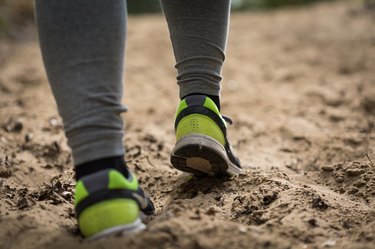
Calf tears are a painful condition that often occur while you're running or jumping. Appropriate exercises for a torn gastrocnemius muscle — the larger of your two calf muscles — depend on the extent of your injury.
According to a case study published in the December 2013 issue of the Journal of the Canadian Chiropractic Association, this injury often occurs in tennis players. Mild muscle tears typically heal with conservative treatment, including calf injury recovery exercises. However, severe calf tears might require surgery. See a doctor if you suspect you have a calf tear.
Video of the Day
Video of the Day
For the best results and to avoid further injury, perform calf tear rehab exercises under the direct supervision of a physical therapist. Avoid aggressive stretching exercises for at least three weeks after injury, advises the Boston Sports Medicine & Research Institute.
Read more: How to Loosen a Tight Calf Muscle
1. Range of Motion Exercises
The gastrocnemius muscle plantarflexes the foot — often referred to as "pointing the toes." Range of motion is often limited after muscle tear, particularly if your ankle has been immobilized. Range of motion exercises for a torn gastrocnemius can begin one week after injury.
Move 1: ABCs
- Sit with your leg straight out in front of you.
- Leading with your big toe, draw the alphabet in the air. Make the letters as big as possible, but move within a pain-free range.
- Complete the alphabet three times.
Move 2: Ankle Pumps
- Sit with your knee straight.
- Point your toes down as far as possible, as if you are pushing on a gas pedal. Hold for three seconds.
- Pull your toes up toward you as far as possible and hold for three seconds.
- Repeat 10 times.
2. Calf Stretches
Stretches are an important component of calf muscle tear rehabilitation. Stretching exercises increase joint mobility beyond your active range of motion. Stretches should not be started until three weeks after an injury, according to the Boston Sports Medicine and Research Institute.
It's common to feel a pulling sensation in your calf when stretching, but if you feel pain, you're stretching too far. Hold stretches for 30 seconds, as recommended by the American Academy of Orthopaedic Surgeons, and repeat three times.
Move 1: Towel Stretch
- Sit with your leg straight out in front of you.
- Loop the towel around the ball of your foot and hold one end of the towel in each hand.
- Gently pull the towel toward you until you feel a stretch in your calf.
Move 2: Wall Calf Stretch
- Stand facing a wall.
- Place your hands against the wall, at about shoulder height.
- Step your affected leg back about 2 feet.
- Keeping your back heel on the floor and knee straight, slowly lean in toward the wall until you feel a stretch in your calf.
Strengthen Your Calf
In most cases, strengthening exercises should be delayed for at least six weeks after injury to allow your damaged muscle to repair itself. Once you're cleared by your doctor or physical therapist, begin calf raises, as demonstrated by ExRx.net, to restore strength in your gastrocnemius muscle.
- Stand with the balls of your feet on a step, with your heels hanging over the edge.
- Slowly rise up on your toes as high as possible.
- Hold for two seconds; then slowly lower back down.
- Repeat 10 times, working up to three sets in a row.
Is this an emergency? If you are experiencing serious medical symptoms, please see the National Library of Medicine’s list of signs you need emergency medical attention or call 911.